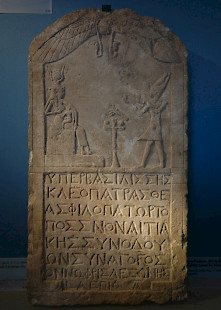Fayyum
Q1399125Fayyum or Lake Moeris: large lake in Egypt, about 80 kilometer southwest of Memphis.

The Fayyum is a depression on the west bank of the river Nile, fed by a channel called Bahr Yussef. The banks of the lake were already occupied in the Chalcolithic age, but the area was developed systematically since the Twelfth Dynasty. In the Hellenistic age, much land was given to Greek-speaking colonists, often veterans. Many towns were built and have Greek names like Soknopaiou Nesos (“island of the god Sobek”), Cynopolis (“dog city”), or Philadelphia (“brotherly love”, after Ptolemy II Philadelphus).
Because the water level was regulated, every village was built on a layer of land that remained comparatively dry. As a consequence, many papyri have survived from these Greek towns.
A special case is Oxyrhynchus (“elephant fish”), which is a bit outside the Fayyum, upstream along the Bahr Yussef. In this city, about half a million fragments (large and small) have been found, documenting every aspect of Egyptian life in the Hellenistic, Roman, and Byzantine era.